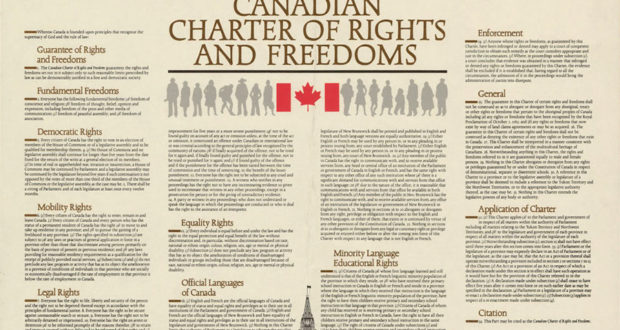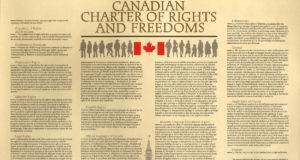The following is the first in a two-part series. Part II will be published next week.
Introduction
In the wake of the legal challenge to Quebec’s law on state secularism,[1] Professor Grégoire Webber, lawyer Eric Mendelsohn and Dean Robert Leckey jointly published a post in which they argue that the invocation of the “notwithstanding clause” in s.33 of the Canadian Charter of Rights and Freedoms does not preclude a court from making a declaration on the “consistency” of the legislative provisions for which s.33 has been invoked with the constitutional rights from which they validly derogate.[2] Let us first review their arguments.
Summary of the Five Arguments to be Assessed
Their first and main argument is textualist, if not literalist. It is based on the wording of subsection 33(2), which states:
An Act or a provision of an Act in respect of which a declaration made under this section is in effect shall have such operation as it would have but for the provision of this Charter referred to in the declaration.
The argument is that, without ever denying the legal effects that validly derogating legislative provisions produce notwithstanding certain sections of the Charter, the courts should be authorized to make declarations of inconsistency between the former and the latter.
Their second argument is that, in the leading case on section 33 of the Canadian Charter—the Ford[3] decision—the Supreme Court of Canada “was not asked about, nor did it rule on, the significance of shielding a law’s operation.”
Their third argument looks to find evidence of the existence of the alleged judicial power in the 2010 decision of the Supreme Court of Canada in Canada v. Khadr.[4] In a 2008 decision,[5] Omar Khadr had previously obtained an order from the Canadian justice system requiring the Canadian government to provide him with transcripts of the interrogations he was subjected to at Guantanamo Bay by Canadian officers, who were aware that Khadr had been subjected to a sleep deprivation technique. This time, he sought judicial review of the Canadian government’s decision to refuse to petition the Unites States authorities for his return to Canada. For a variety of reasons stemming from evidentiary uncertainty, the limits of its institutional jurisdiction in foreign affairs and the “need to respect the prerogative powers of the executive,”[6] the Court concluded that it was not appropriate to grant the order sought. Instead, the Court thought best to limit itself to making a declaration, including of the fact that Canada has “deprive[d] him of his right to liberty and security of the person guaranteed by s. 7 of the Charter, contrary to the principles of fundamental justice”[7] (which is a condition of s. 7 violation). Our colleagues’ argument is therefore that the Khadr decision is evidence that courts can always make declarations rather than grant alternative relief. According to them, the Khadr decision demonstrates that judicial declarations of mere “inconsistency” of valid exception-to-rights provisions with the very provisions of the Charter from which they so derogate would be “consistent with what the courts already do.”
Their fourth argument is again illustrative, yet this time drawn from foreign legal systems, in this case the law of the United Kingdom, New Zealand and Australia, which “all provide that judges may declare legislation incompatible with human rights, but such declarations do not affect the operation of legislation.”
Jumping into the playing field a dozen days after the publication of Professor Webber et
al.’s post, Professor Leonid Sirota intervened in the debate supporting
the above arguments, while adding another of his own: “One provision that is
not subject to section 33 is section 24, the Charter’s internal remedial
provision.”[8] While Professor Sirota had in this only wanted
to advance the claim that the exercise of the power provided for under section
33 would not prevent courts from making “declarations of inconsistency,” Dean
Leckey used this new fifth argument in a short piece he published soon
thereafter to bring forth an even bolder one: the fact that statutory
provisions validly derogate from certain rights found in the constitutional
charter would not preclude the remedy for damages which the case law[9] recognizes for, as section 24(1) of the Charter
reads, “[a]nyone whose rights or freedoms, as guaranteed by this Charter,
have been infringed or denied.”[10] Our colleague invokes here
the distinction accepted in administrative law between what is invalid and what
gives rise to civil liability.[11] In his view, because state action that is
legally valid may nevertheless give rise to civil liability, it is conceivable
that the state may also incur civil liability by enacting legislation that is validly
“inconsistent” with rights (from that legislation is validly excepted from).
Assessment of the First Argument on Textual Clarity
How should we assess the strength of these aforementioned arguments? Let us begin by pointing out that mere literal interpretation is fortunately not accepted in our law. Of course, the text of the supreme law[12] can never be ignored,[13] and that which is absolutely clear must prevail, but we still need to know over what it prevails.In other words, the constitutional interpreter is not allowed to just ignore the scheme of the provisions and structure of the supreme law, which the Supreme Court has referred to as an “architecture”[14] and from which it even allows itself to infer “unwritten principles.”[15]
Indeed, the interpretive method of our supreme law remains irreducibly that of the meaning given to it by the purpose (telos) of the provisions to be interpreted, a method that the Supreme Court thus calls “purposive.”[16] This “purpose” could also be represented as a function, so as to speak of a functionalist method. In any case, the clarity of the text of a constitutional provision can only reveal its object, or function. If any doubt as to the function of one or more provisions remains after reading the supreme law, the interpreter is entitled to consider the “extrinsic” evidence of the framers’intention.
Taken in isolation, the use of the words “has the effect that it would have except for the provision of the Charter” in subsection 33(2) of the Canadian Charter is nowhere close to being sufficient in revealing the function of section 33, which alone can give it meaning. This textual excerpt is therefore on its own unclear. Does it become clear in light of the scheme of the section’s provisions? The exclusion of any substantive review – confirmed by the Supreme Court in Ford[17] –, the requirement of an express declaration of intent, and the temporary nature of the exception all support the argument that the function of section 33 is to allow legislators to exempt provisions from any judicial debate on their respect for the constitutional rights from which they derogate. Should there remain any doubt in the mind of the interpreter, consideration of evidence of the intention of the framers the Constitutional Act, 1982 itself, should be sufficient to dispel it. This evidence seems indeed rather overwhelming, at least as provided by Professor Dwight Newman.[18] After analyzing the evidence, Professor Newman concluded that the intent behind section 33 was that “legislative bodies [would] have the legal authority to substitute their view of a particular rights conflict or rights interpretation for the view at which courts have arrived.”[19] For us, it could hardly be clearer.
Assessment of the Second Argument on the Ford Decision
The negative argument based on the Ford decision leaves us puzzled. In this case, the Supreme Court never contemplated making any declaration about the relationship of section 58 of Quebec’s Charter of the French Language[20] to s.2(b) of the Charter, guaranteeing freedom of expression, since that statutory provision was protected by a declaration of exception to ss.2 and 7 to 15 of the Charter, a declaration that was valid and still in force. Moreover, in distinguishing the exception to rights from the limitation of rights under s.1, the Supreme Court in this case confirmed that, unlike the exception, the limitation could not have the effect of totally suspending the right with regard to the limitating measure. [21] Finally, this decision went so far as to admit the possibility of using an “omnibus notwithstanding clause” to state that all legislation from the same provincial legislature or Parliament shall continue to operate notwithstanding ss.2 and 7 – 15 of the Charter. This all indicates that the Court was very much alive to the meaning of s.33 and its significant legal effects: its use suspends, or sets aside, the right in relation to a variable and unlimited number of identified, or identifiable, provisions, so that, on the substantive relation between that right and these provisions, courts simply have nothing to declare.
Assessment of the Third Argument on the Khadr Decision
In our view, the illustrative argument from the Khadr case also
fails. Courts can obviously declare a violation of rights. So far, nothing new
has been said. The most relevant question that preoccupies us is whether they may,
or even logically can, declare the hypothetical, virtual “infringement” or
“denial” of constitutional rights that have been temporarily suspended in
respect of particular legislative provisions. Put another way, whether they can
declare the “inconsistency” of particular legislative provisions with rights
that are validly excepted from. In the Khadr case, section 7 had not
been derogated from by means of valid applicable statutory provisions. Had this
been the case, the Court would not have made its declaration. Of course, courts
can declare that Charter rights have been violated by the state and, as within
their jurisdiction, they can do so rather than granting the remedy sought. Can
they thereby declare the virtual “inconsistency” of exception-to-rights
provisions with the very constitutional rights from which they are validly
excepted? We do not think so, but if one thing is certain, it is that the
jurisprudence does not provide us with any example of this. There would be no
point, then, in objecting here with decisions such as Manitoba Metis
Federation[22]—at
least so long as the Supreme Court is correct in referring to the principle of
the “honour of the Crown” as a genuinely legal principle which “speaks to how obligations
that attract it must be fulfilled”[23]—or
Ewert v. Canada.[24] In the former case, the Supreme Court issued a declaration of
non-fulfillment of constitutional obligations by the federal Crown while
personal remedies claims had lapsed.[25]
In the latter case, the Court made a declaration of breach of an obligation bestowed
on the Correctional Service of Canada by federal statute, where the statutory
grievance mechanism provided to the plaintiff had not been effective.[26]
In neither case had the correlative legal right or interest been legally
inexistent or of no substantive force at the time of the facts. In both, the
declaration was made in order to ensure that a right or legal interest was not
without any remedy, not in a way as to grant a remedy without a right or legal
interest at the time of the facts.
[1] Act respecting the laicity of the State, CQLR c L-0.3.
[2] Grégoire Webber, Eric Mendelsohn et Robert Leckey, “The faulty received wisdom around the notwithstanding clause” (10 May 2019) Policy Options Politiques, online : <https://policyoptions.irpp.org/magazines/may-2019/faulty-wisdom-notwithstanding-clause/>.
[3] See Ford v Quebec (Attorney General), [1988] 2 SCR 712 [Ford].
[4] Canada (Prime Minister) v Khadr, 2010 SCC 3, [2010] 1 SCR 44 [Khadr].
[5] Canada (Justice) v Khadr, 2008 SCC 28, [2008] 2 SCR 125.
[6] Khadr, supra note 4 at para 46.
[7] Ibid at para 48.
[8] Léonid Sirota, “Concurring Opinion” (23 May 2019) Double Aspect, online <https://doubleaspect.blog/2019/05/23/concurring-opinion/>.
[9] See Vancouver (City) v. Ward, 2010 SCC 27, [2010] 2 SCR 28.
[10] The Constitution Act, 1982, Schedule B to the Canada Act 1982 (UK), 1982, c 11 at para 24(1) [Canadian Charter of Rights and Freedoms] ; Robert Leckey, “Advocacy Notwithstanding the Notwithstanding Clause” (2019) 8:4 Constitutional Forum Constitutionnel 1.
[11] See Canada (Attorney General) v TeleZone Inc., 2010 SCC 62, [2010] 3 SCR 585.
[12] See Maxime St-Hilaire, Patrick F. Baud and Elena S Drouin, “The Constitution of Canada as Supreme Law: A New Definition” (2019) 28:1 Constitutional Forum constitutionnel 7.
[13] We would oppose any conception of the “living tree” doctrine that would be forgetful of the “natural limits” part the famous analogy made in “Edwards” (Re Section 24 of the BNA Act, sub nom Edwards v Canada (Attorney General), [1930] AC 124 (PC), at 106–7)and that would allow itself to simply ignore the text of the supreme law.
[14] Reference re Senate Reform, 2014 SCC 32 at paras 26–27, [2014] 1 SCR 704.
[15] Reference re Secession of Quebec, [1998] 2 SCR 217.
[16] See Hunter et al. v Southam Inc., [1984] 2 SCR 145.
[17] See Ford, supra note 3 at para 33.
[18] See Dwight Newman, “Canada’s Notwithstanding Clause, Dialogue, and Constitutional Identities” in Geoffrey Sigalet, Grégoire Webber and Rosalind Dixon, eds., Constitutional Dialogue: Rights, Democracy, Institutions (Cambridge: Cambridge University Press, 2019) at 209–34.
[19] Ibid at 227.
[20] CQLR c C-11.
[21] Ford, supra note 3 at paras 65–66.
[22] Manitoba Metis Federation Inc. v Canada (Attorney General), 2013 SCC 14, [2013] 1 SCR 623 [Manitoba Metis Federation].
[23] Ibid at para 73.
[24] Ewert v Canada, 2018 SCC 30, [2018] 2 SCR 165 [Ewert].
[25] See Manitoba Metis Federation, supra note 21 at paras 6–9, 143–44.
[26] See Ewert, supra note 24 at para 7, 27, 83–84.
 Advocates for the Rule of Law
Advocates for the Rule of Law




Pretty dank.